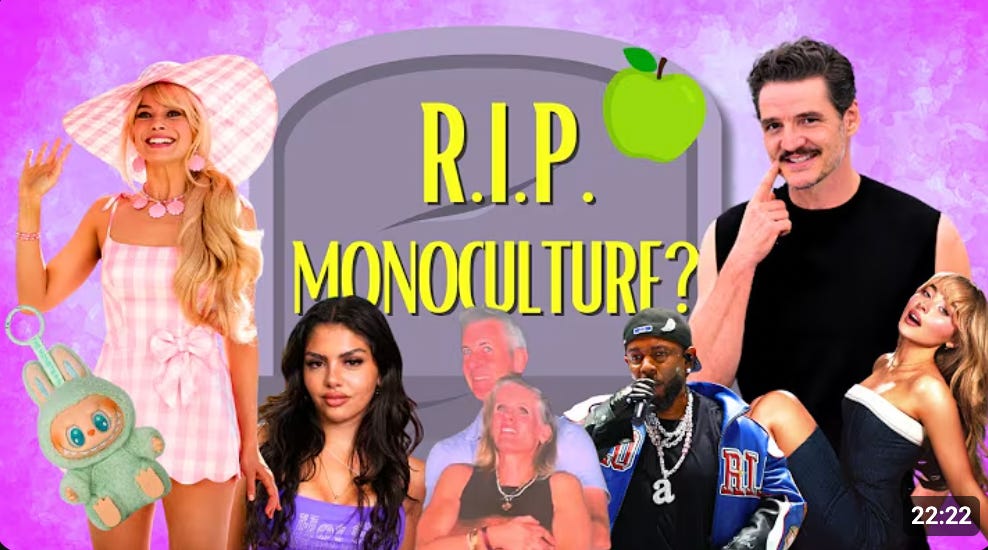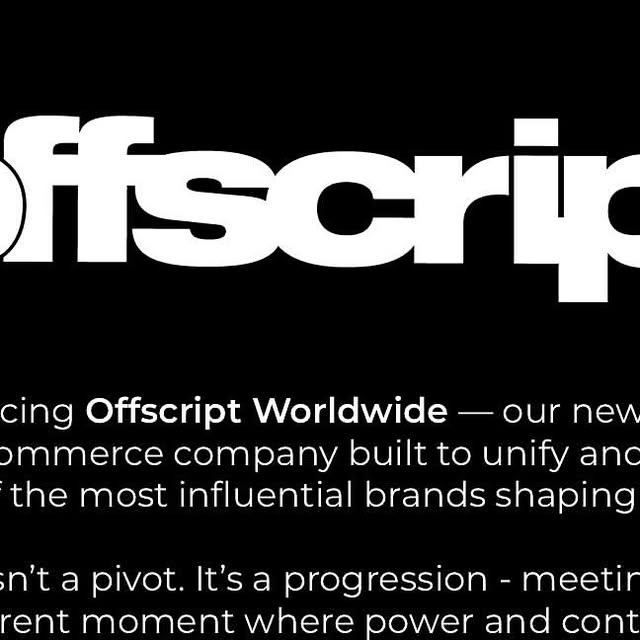Monoculture may be dead. It’s time to bet on the cultures that were never center stage.
How Offscript and Revry are engineering cross-platform ecosystems.
No summer blockbusters, no song of summer, no viral memes, no universal water cooler talk.
This year we’ve lacked a Titanic, a Hot In Herre, a Charlie Bit Me. Save for sports or politics, we’re in a drought when it comes to cohesive cultural and media moments, perhaps since the full scale assault that was Barbie. Discourse from YouTube to the New York Times is hailing 2025 as the death of monoculture - that is, the end of universal, unifying media events that lead the pop culture zeitgeist.
Here’s the case they’re making - the media landscape is so fractured that it’s impossible to have universally shared moments. First, TikTok’s algorithm-focused feed brought on a full dispersion of the internet - no one sees the same version of their FYP. Other platforms took note, implementing similar tactics. With competitors like Instagram notably nixing the chronological timeline, fewer and fewer people see the same thing at the same time.
Secondly, the splintering of long form content across streaming platforms, YouTube and podcasts as attention mediums have furthered a fractured media landscape. While the huge selection of early 2000s cable channels allowed for widened content across lifestyles and interests (I was an HGTV kid myself); these new platforms allow for the same with the additions of on-demand viewing, creator led content and algorithm-driven recommendations. This has created content cohorts or media bubbles, with less overlap than in the past.

TVREV’s Alon Wolk writes about the concept of ‘feudal media’ to encapsulate this moment:
“One of the most significant changes of the 2020s has been the rise of “feudal media”—self-contained bubbles of more personalized media: podcasts, substacks, TikTok channels and the like, each attended to by passionate fan bases who are largely unaware of much of what is going on outside of their particular universe.”
Though none of this is necessarily new for diverse audiences — Black, LGBTQ+, Asian, Hispanic, and beyond have always lived outside of mass culture’s center.
Growth in cable offerings gave us our first view of a young, pre-Broadway domination Cole Escola. Logo’s Jeffery and Cole Casserole brought niche queer humour to a purposefully queer audience. In the 2010s Black humourists originated trends that travelled across the social landscape like #BeyonceAlwaysOnBeat and #ThisCouldBeUsButYouPlaying, becoming months-long dialogues between creators adding their own takes. And of course, we know the huge numbers Latin artists have done in the U.S. for several decades.
The mass media landscape of the past century recalls James Baldwin’s rumination on America’s racial and societal divide: “And furthermore, you give me a terrifying advantage. You never had to look at me. I had to look at you. I know more about you than you know about me.”
So, while we grapple with what the death of monoculture means for mainstream media, what does it mean for minority-focused media and their audiences? While the buying power for diverse audiences continues to increase, investment continues to lag.
We’re seeing multicultural media brands like Revry and Revolt TV’s new parent company, Offscript tap into our fractured media ecosystem, tailoring cohort-specific offerings that harness both content and creator. During Advertising Week New York, Damian Pellicone, CEO and co-founder of Revery, the global streaming network that launched in 2016 focused on queer content and creators, stressed the importance of contextualizing audiences—making the case for brand investment. Buying power for the LGBTQ+ community alone topped $1.4 Trillion in recent years. Not only that - the group’s household income is also double that of the national average, with LGBTQ+ consumers said to be both brand loyal and early adopters in trends and tech.
Offscript is focusing on creators with proven ability to hold both long and short form attention—from YouTube and streaming to Instagram and TikTok—to create fully vertically aligned ecosystems. This strategy offers consumers a one stop shop into a specific hip-hop culture focused media bubble for brands.
Both Offscript and Revry are engineering around the idea of feudal media, building cross-platform ecosystems that help brands better adapt to the death of monoculture. It’s a bet on where many predict media is going; advertisers, marketers and communicators will need to recognize the bubbles their audience fall into and treat them as essential, not niche.
That may look like organizing strategic work around distinct cultural ecosystems rather than chasing one broad audience. Instead of thinking in traditional “channel” terms, brands should break their budgets and strategies down by media bubble. This also has staffing implications: organizations need strategists with intimate understanding of specific cultural bubbles — not just broad demographics.
As monoculture fades, the challenge for brands isn’t just to find their audience, it’s in understanding the media bubbles they engage with. Success will depend on mastering the nuances of smaller, self-contained cultural worlds and earning their trust. This isn’t just a minority-audience challenge, it’s a universal shift.
Every audience is now a subculture, every “mainstream” an illusion of overlap. The brands that organize around these ecosystems (e.g., strategists fluent in their language, creators embedded in their networks, and campaigns designed to move organically between platforms) won’t just survive the death of monoculture; they’ll define what comes next.
Stefan Embry is a contributor to Brand&Culture and consultant at Marcom Company, the publisher of this publication.






